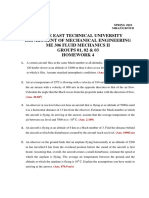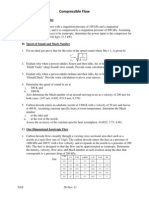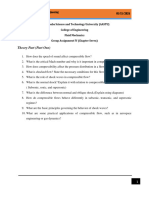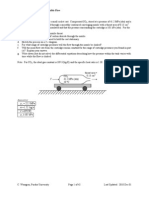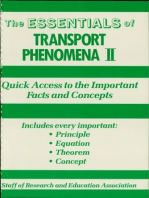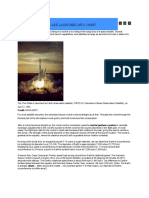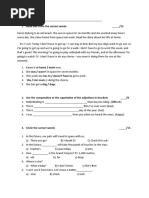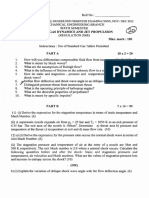0 ratings0% found this document useful (0 votes)
135 viewsModule 4 Questions
1. The document provides information about 8 problems related to compressible flow through nozzles. The problems involve calculating properties like pressure, temperature, area, velocity and Mach number at various points in converging-diverging nozzles given parameters like inlet conditions, mass flow rate, exit area and ambient conditions.
2. It also provides specifications for an RD-170 rocket engine to calculate its thrust and specific impulse at different altitudes.
3. The problems cover concepts like one-dimensional compressible flow, isentropic flow, stagnation properties and their use in nozzle analysis.
Uploaded by
Zoë NightshadeCopyright
© © All Rights Reserved
Available Formats
Download as DOCX, PDF, TXT or read online on Scribd
0 ratings0% found this document useful (0 votes)
135 viewsModule 4 Questions
1. The document provides information about 8 problems related to compressible flow through nozzles. The problems involve calculating properties like pressure, temperature, area, velocity and Mach number at various points in converging-diverging nozzles given parameters like inlet conditions, mass flow rate, exit area and ambient conditions.
2. It also provides specifications for an RD-170 rocket engine to calculate its thrust and specific impulse at different altitudes.
3. The problems cover concepts like one-dimensional compressible flow, isentropic flow, stagnation properties and their use in nozzle analysis.
Uploaded by
Zoë NightshadeCopyright
© © All Rights Reserved
Available Formats
Download as DOCX, PDF, TXT or read online on Scribd
You are on page 1/ 1
CHOOSE 5 ONLY 5.
In a nozzle, the pressure and
temperature of the reservoir is
1. Airstream flows in a converging
500kPa and 882K, respectively. If
duct from a cross-sectional area
the flow rate along the nozzle is
A1=50cm2 to a cross-sectional
constant at 170.1 kg/s, compute
area A2=40cm2. If T1=300K,
for the area at the throat.
P1=100kPa, and V1=100m/s,
6. A high-speed subsonic aircraft is
find M2, P2, and T2. Assume
flying with velocity of 170 m/s, at
Quasi-One-Dimensional Flow.
an altitude where the pressure
2. On the given parameters from
and temperature are 101300 Pa
problem 1, compute for the area,
and 290 K, respectively. Calculate
velocity, pressure, and
the pressure at the stagnation
temperature at the throat.
point. Assume R = 287.08 J/kg.K
3. Air is allowed to flow from a large
and k = 1.4.
reservoir through a C-D nozzle
7. An aircraft is flying at an altitude
with an exit area of 50x10-4m2.
with an ambient pressure of
The reservoir is large enough so
101325 Pa. A pitot tube mounted
negligible changes in reservoir
on the wing tip measures a
pressure and temperature occur
pressure of 202650 Pa. Calculate
as fluid exhausted through the
the Mach number at which the
nozzle. Assume isentropic, steady
aircraft is flying. Assume k =
flow in the nozzle with
1.39.
PR=500kPa and TR=500K;
8. For an RD-170 rocket engine,
assume also that air behaves as a
compute for its thrust. Also,
perfect gas with constant specific
compute for its specific impulse
heat, k=1.4. Determine the mass
(both per unit mass and weight)
flow through the nozzle for an
at SSLC and at 45000ft. It’s given
exit pressure of (a) 250kPa, (b)
parameters is as below:
375kPa, and (c) 500kPa.
PR =24,520,000 Pa
4. On the given parameters on the
TR = 3676K
reservoir on number 3, with an
AE/A* = 36.87
exit pressure of 100kPa, compute
de = 3.8m
for the pressure, temperature,
and area for the section of the
nozzle with Mach number equal
to 0.25, 0.5, 0.75, 1, 1.25, and
1.5, if the exit area is 100cm2.
Also compute for the Mach
number and temperature at the
exit.
You might also like
- Modern Engineering For Design of Liquid (001-122)No ratings yetModern Engineering For Design of Liquid (001-122)122 pages
- CW. Assignment (20 Mark), For 4 MR Due To The Day of The Final ExamNo ratings yetCW. Assignment (20 Mark), For 4 MR Due To The Day of The Final Exam3 pages
- Gojan School of Business and Technology, Chennai-51 Model Examinations-April-2017No ratings yetGojan School of Business and Technology, Chennai-51 Model Examinations-April-20174 pages
- Compressible Fluid Flow 2018 Aug (2006 Ad)No ratings yetCompressible Fluid Flow 2018 Aug (2006 Ad)2 pages
- B.E./B.Tech.: St. Xavier's Catholic College of Engineering, Chunkankadai, Nagercoil - 629 003No ratings yetB.E./B.Tech.: St. Xavier's Catholic College of Engineering, Chunkankadai, Nagercoil - 629 0032 pages
- Solution Manual Gas Dynamics 3rd Edition James Ea John Theo GNo ratings yetSolution Manual Gas Dynamics 3rd Edition James Ea John Theo G10 pages
- Sheet 6: Compressible Flow in Nozzles: Stagnation PropertiesNo ratings yetSheet 6: Compressible Flow in Nozzles: Stagnation Properties3 pages
- Use of Gas Tables Permitted, Assume Suitable Value For Missing DataNo ratings yetUse of Gas Tables Permitted, Assume Suitable Value For Missing Data2 pages
- Use of Gas Tables Permitted, Assume Suitable Value For Missing DataNo ratings yetUse of Gas Tables Permitted, Assume Suitable Value For Missing Data2 pages
- Gas Dynamics and Jet Propulsion: Faculty of Engineering B.Tech. - Mechanical EngineeringNo ratings yetGas Dynamics and Jet Propulsion: Faculty of Engineering B.Tech. - Mechanical Engineering8 pages
- Compressible Fluid Flow 2017 April (2012 Ad)No ratings yetCompressible Fluid Flow 2017 April (2012 Ad)2 pages
- ME6604 Gas Dynamics and Jet Propulsion TutorialNo ratings yetME6604 Gas Dynamics and Jet Propulsion Tutorial10 pages
- AE6015 - Rockets and Missiles Part - A (8 X 3 24) Answer Any Eight QuestionsNo ratings yetAE6015 - Rockets and Missiles Part - A (8 X 3 24) Answer Any Eight Questions2 pages
- Sky girls: the true story of the first women's cross-country air race Recorded Books All Chapters Instant DownloadNo ratings yetSky girls: the true story of the first women's cross-country air race Recorded Books All Chapters Instant Download55 pages
- Design of A Composite Oxidizer Tank For A Hybrid Sounding RocketNo ratings yetDesign of A Composite Oxidizer Tank For A Hybrid Sounding Rocket133 pages
- 054 - ME6604 Gas Dynamics and Jet Propulsion - Question Bank 2No ratings yet054 - ME6604 Gas Dynamics and Jet Propulsion - Question Bank 29 pages
- NCERT Solutions For Class 7 English An Alien Hand Chapter 10No ratings yetNCERT Solutions For Class 7 English An Alien Hand Chapter 103 pages
- Space Suttle: History of The Space ShuttleNo ratings yetSpace Suttle: History of The Space Shuttle22 pages
- Multidisciplinary Design Optimization Approach and Its Application To Aerospace EngineeringNo ratings yetMultidisciplinary Design Optimization Approach and Its Application To Aerospace Engineering5 pages
- Me 9026 Gas Dynamics and Jet Propulsion Time: 3 HR Max. Mark: 100No ratings yetMe 9026 Gas Dynamics and Jet Propulsion Time: 3 HR Max. Mark: 1002 pages
- Introduction to Aerospace Flight VehiclesNo ratings yetIntroduction to Aerospace Flight Vehicles2,881 pages
- Keane Hessing Year 9 STEM Folio Final T2No ratings yetKeane Hessing Year 9 STEM Folio Final T24 pages





